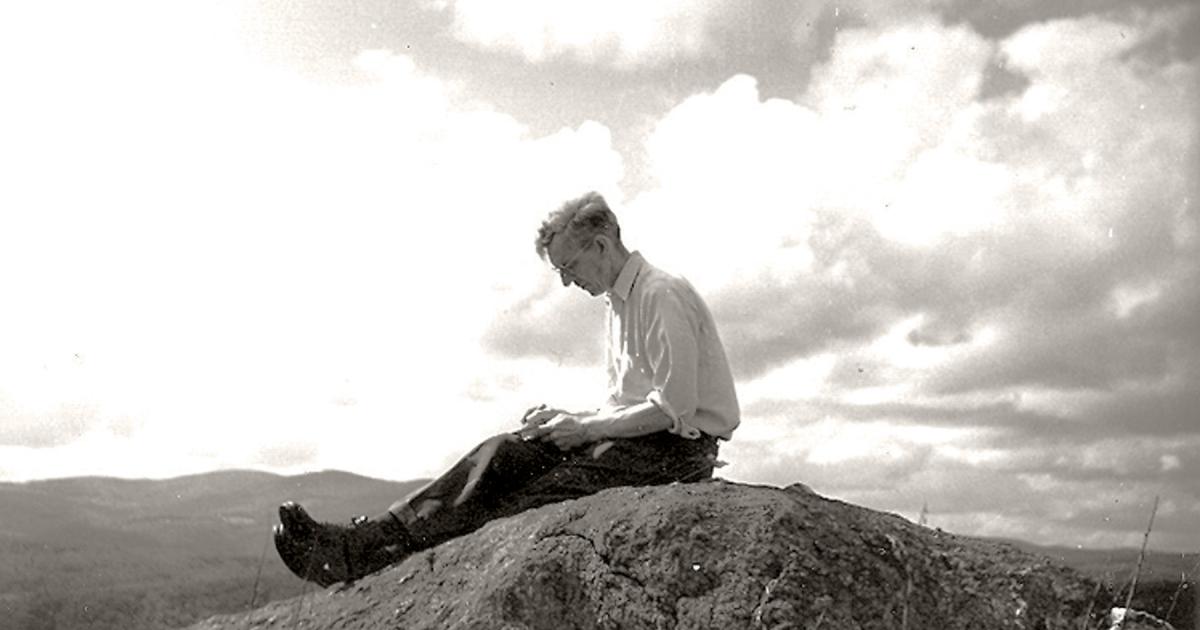Best known as the originator of the Appalachian Trail, Benton MacKaye (1879–1975) was an American forester, planner and conservationist.
Born in Stamford, Connecticut on March 6, 1879 to actor and dramatist Steele MacKaye and his wife Mary, Emile Benton MacKaye was the sixth of seven children. Benton had five older brothers and a younger sister, Hazel.
When his second oldest brother William purchased a small estate in Shirley, Massachusetts, a quiet town west of Boston, in July 1888, the family moved into their first home. Eight-year-old Benton was immediately taken with the beauty of life in the country and the freedom it offered. “The Cottage” became MacKaye’s true home for the remainder of his life.
Upon his father’s death in 1894, MacKaye became head of the household as his older brothers were attending college. Struggling with the loss of a father who was often absent, he enrolled in the Cambridge Latin School. Despite enjoying Boston, by December he had made the decision to drop out and study independently for the entrance exams to Harvard University. MacKaye was accepted into Harvard and began classes in October 1896, graduating four years later.
During his undergraduate studies, John Muir, mountaineer and founder of the Sierra Club, and Gifford Pinchot, chief of the US Division of Forestry, visited Harvard. Their passionate lectures about the challenges facing American forests and their enlightened views on the wilderness moved the seventeen-year-old. MacKaye embarked on his first hike in the mountains of northern New England after his freshman year, an experience that influenced his future response to the world around him.
In October 1903, as the forestry profession began to establish itself, MacKaye returned to graduate school, enrolling in Harvard’s new forestry school. He became the first to graduate in 1905, earning a Master of Forestry, and would spend the next five years alternating between teaching at the school in Petersham, Massachusetts, and working as a Forest Assistant with the US Forest Service.
In 1909, a change in Presidential administrations and controversy surrounding Pinchot’s dismissal from the Forest Service were disruptive to the conservation movement and MacKaye found himself unemployed, creating a crisis for his family. With the advice of his sister Hazel, he completed the textbook, A Theory of Forest Management, using the planning of a Peterborough, New Hampshire estate as a key case study. Unable to find a publisher, he shared it with the Forest Service chief, Henry Graves, who offered him a job in Washington, D.C.
In Washington, MacKaye became involved with progressive leaders of the conservation movement. In 1913 he met Jessie Hardy “Betty” Stubbs, a suffragist, who he married in June 1915. The two pursued their independent careers with MacKaye traveling the country for his Forest Service work and Betty accompanying him doing suffrage work.
Not long after Betty’s death in 1921, MacKaye proposed the idea of hiking a path along the ridge line of the Appalachian Mountains. Refining his plans, he first published his idea for the Appalachian Trail in the October 1921 edition of the Journal of American Institute of Architects in an article entitled “An Appalachian Trail: A Project in Regional Planning.” The article detailed his plan for the trail and proposed setting aside wild lands along the route similar to those being created in the West.
Following the article, new hiking clubs emerged and the Committee on Community Planning became the trail’s major benefactor. In 1925 the disparate groups converged to form the Appalachian Trail Conference. Work proceeded quickly and a footpath running from Maine’s Mount Katahdin to Georgia was completed in 1937.
In 1935, MacKaye, with other prominent wilderness supporters including Bob Marshall and Aldo Leopold, founded the Wilderness Society, the first national organization dedicated to the preservation of the wilderness. The group’s influence grew steadily, impacting government policy and public consciousness. Ten years later, MacKaye was elected president, eventually becoming honorary president, a title he held throughout his life. His involvement and energy inspired veterans and newcomers alike to the wilderness cause.
His work on conservation and open space led to him being awarded the prestigious Conservation Service Award of the US Department of the Interior in January 1966. In recognizing the recipient, The Honorable Stewart L. Udall, Secretary of the Interior, remarked,
“You foresaw the need and laid the foundation for present day’s protection of man’s total environment … before the nation as a whole awoke to its need. …. That this [wilderness] society lives and thrives and continues to serve the people through the preservation of the finest examples of native American environments, from which future generations will gain strength and inspiration, is due in great part to your foresight.”
In 1979, the Benton MacKaye Trail Association was founded and in 2011 Benton MacKaye was inducted into the Appalachian Mountain Club Hall of Fame.
MacKaye died on December 11, 1975 at the age of 96.
Sources: Shirley Historical Society, Wikipedia, Wilderness.net

